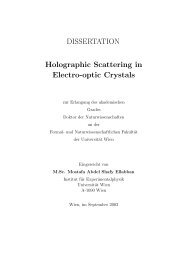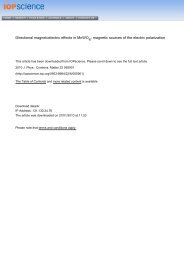PhD (PDF) - Universität Wien
PhD (PDF) - Universität Wien
PhD (PDF) - Universität Wien
Sie wollen auch ein ePaper? Erhöhen Sie die Reichweite Ihrer Titel.
YUMPU macht aus Druck-PDFs automatisch weboptimierte ePaper, die Google liebt.
Abstract<br />
Scattering and diffraction experiments proved to be extremely useful for materials investigation<br />
and have developed to standard techniques in condensed matter sciences. Depending on the<br />
desired information and the size of the scattering or diffraction objects, quanta are chosen<br />
having an appropriate interaction with the object as well as appropriate momentum. The most<br />
common ones being light, x-rays, electrons and neutrons.<br />
As the characteristics of the scattered or diffracted radiation reflects the correlation between<br />
the quantum field and the structure of the scatterer it is of utmost importance for the correct<br />
interpretation of diffraction and scattering experiments to determine the coherence properties of<br />
the scattering radiation [1]. The coherence of the beam is characterised by its coherence volume,<br />
a quantity which can be measured by interferometry. For thermal neutrons this task was perfor-<br />
med using a perfect silicon-crystal interferometer [2, 3]. In material sciences cold neutrons in a<br />
wavelength range between 0.6 nm and 1.3 nm are frequently employed for investigations of large-<br />
scale structures, e.g. for structure analysis of biological materials (viruses, proteins, enzymes),<br />
in metallurgy (alloys, magnetic and superconducting materials) or for polymer research. The<br />
continuous development of cold neutron sources and the increasing number of applications at<br />
small-angle scattering facilities for cold neutrons illustrate the demand for a device to determine<br />
the coherence properties of a cold neutron beam.<br />
Here we report on the setup and adjustment of a new Mach-Zehnder type interferometer for cold<br />
neutrons based on holographically generated gratings in triple Laue geometry. We employed<br />
the photo-neutronrefractive effect of DMDPE - doped deuterated poly(methylmethacrylate)<br />
to perform the first direct measurement of the coherence function for cold neutrons. This<br />
task is done by continuously increasing the phase difference between two beam paths of the<br />
interferometer through rotation of a phase-flag. The decay of interference fringes is monitored<br />
and thus the coherence function determined experimentally.<br />
Evaluation of the interference pattern allows to determine the coherence length of the neutron<br />
beam, the coherent scattering length density of the phase-flag and the absolute phase of the<br />
third interferometer grating. The experimental determination of the intensity and the phase<br />
of the scattering radiation permits a direct Fourier transform from reciprocal to real space and<br />
thus the solution of the ”phase problem” in neutron scattering.<br />
I






